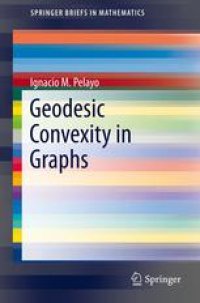
Ebook: Geodesic Convexity in Graphs
Author: Ignacio M. Pelayo (auth.)
- Tags: Graph Theory, Differential Geometry, Partial Differential Equations
- Series: SpringerBriefs in Mathematics
- Year: 2013
- Publisher: Springer-Verlag New York
- Edition: 1
- Language: English
- pdf
Geodesic Convexity in Graphs is devoted to the study of the geodesic convexity on finite, simple, connected graphs. The first chapter includes the main definitions and results on graph theory, metric graph theory and graph path convexities. The following chapters focus exclusively on the geodesic convexity, including motivation and background, specific definitions, discussion and examples, results, proofs, exercises and open problems. The main and most studied parameters involving geodesic convexity in graphs are both the geodetic and the hull number which are defined as the cardinality of minimum geodetic and hull set, respectively. This text reviews various results, obtained during the last one and a half decade, relating these two invariants and some others such as convexity number, Steiner number, geodetic iteration number, Helly number, and Caratheodory number to a wide range a contexts, including products, boundary-type vertex sets, and perfect graph families. This monograph can serve as a supplement to a half-semester graduate course in geodesic convexity but is primarily a guide for postgraduates and researchers interested in topics related to metric graph theory and graph convexity theory.
Geodesic Convexity in Graphs is devoted to the study of the geodesic convexity on finite, simple, connected graphs. The first chapter includes the main definitions and results on graph theory, metric graph theory and graph path convexities. The following chapters focus exclusively on the geodesic convexity, including motivation and background, specific definitions, discussion and examples, results, proofs, exercises and open problems. The main and most studied parameters involving geodesic convexity in graphs are both the geodetic and the hull number which are defined as the cardinality of minimum geodetic and hull set, respectively. This text reviews various results, obtained during the last one and a half decade, relating these two invariants and some others such as convexity number, Steiner number, geodetic iteration number, Helly number, and Caratheodory number to a wide range a contexts, including products, boundary-type vertex sets, and perfect graph families. This monograph can serve as a supplement to a half-semester graduate course in geodesic convexity but is primarily a guide for postgraduates and researchers interested in topics related to metric graph theory and graph convexity theory.
Geodesic Convexity in Graphs is devoted to the study of the geodesic convexity on finite, simple, connected graphs. The first chapter includes the main definitions and results on graph theory, metric graph theory and graph path convexities. The following chapters focus exclusively on the geodesic convexity, including motivation and background, specific definitions, discussion and examples, results, proofs, exercises and open problems. The main and most studied parameters involving geodesic convexity in graphs are both the geodetic and the hull number which are defined as the cardinality of minimum geodetic and hull set, respectively. This text reviews various results, obtained during the last one and a half decade, relating these two invariants and some others such as convexity number, Steiner number, geodetic iteration number, Helly number, and Caratheodory number to a wide range a contexts, including products, boundary-type vertex sets, and perfect graph families. This monograph can serve as a supplement to a half-semester graduate course in geodesic convexity but is primarily a guide for postgraduates and researchers interested in topics related to metric graph theory and graph convexity theory.
Content:
Front Matter....Pages i-viii
Introduction....Pages 1-8
Invariants....Pages 9-38
Graph Operations....Pages 39-56
Boundary Sets....Pages 57-68
Steiner Trees....Pages 69-79
Oriented Graphs....Pages 81-90
Computational Complexity....Pages 91-93
Back Matter....Pages 95-112